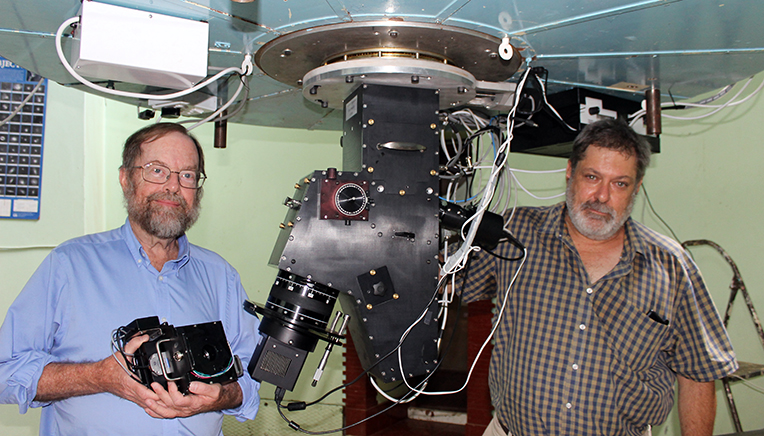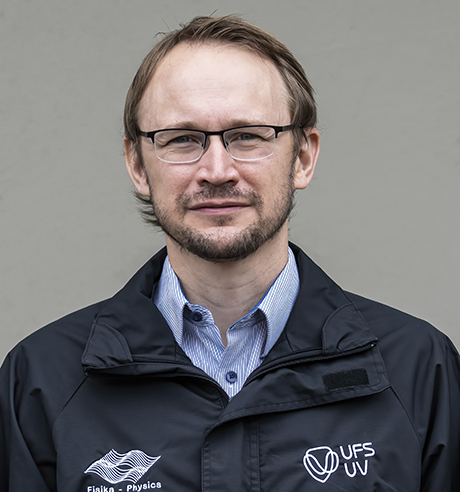The University of the Free State (UFS) is gearing up to be a leading academic institution in astronomical research. The institution successfully mounted a spectrograph with a polarimeter to the
Boyden Observatory 1,5-m telescope that will provide scientists with visual access to both the Northern and Southern Hemispheres.
The instrument, which can be accessed from Boyden, an astronomical research observatory and science education centre a few kilometres outside Bloemfontein, will allow researchers such as the Astrophysics Group at the UFS to do simultaneous polarimetry
and spectroscopy of astronomical sources. This is vital for the research they are working on.
Mounting the spectrograph to the telescope and installing the polarimeter completed the upgrade of the 1,5-m telescope and is a leap forward for the astrophysics group at the UFS. The upgraded telescope with the spectropolarimeter, with a valued cost
of R1.5 million, will also provide unique opportunities for collaborative research between the Astrophysics Groups at the UFS and researchers from the
Appalachian State University (ASU). This adds greatly to the astrophysics research capacity at the university.
Prof Richard Gray, who 2019 started with the development of the astronomical spectrograph for the UFS Department of Physics, is a world-renowned expert in stellar spectroscopy, from the
Department of Physics and Astronomy at ASU in North Carolina in the US. He was mainly responsible for the development and building of the instrument.
Prof Pieter Meintjes, Senior Professor from the
UFS Department of Physics,
describes the moment that installation was completed as a feeling of enormous relief. “It took many hours of hard work, planning and testing to marry the 90-year 1,5-m telescope with the new sophisticated instrument,” he says.
Adding value to graduate programme
Besides the development and installation of the spectrograph, Prof Gray also designed and built a polarimeter which can be integrated with the spectrograph. When placed inside the spectrograph, this piece of equipment transforms the spectrograph into
a spectropolarimeter, giving it additional functionality. “This allows us, for example, to detect and analyse polarised light. It enables us to study the effect of magnetic fields in astronomical sources which introduce various polarisation
signatures that can be detected with the polarimeter,” explains Prof Gray.
“I am fascinated by the polarimetric capabilities that we never had before. It is a great step forward,” remarks Prof Meintjes.
“The Department of Electronics and Instrumentation at the UFS played an enormous role in the building of several components of the instrument that Prof Gray designed, as well as getting the 1.5-m telescope research ready so that the completed instrument
could be mounted to the telescope”, says Prof Meintjes
He envisages that the research instrument will be ready for research purposes by March this year. Up till then researchers, graduates, and third-year students will have the opportunity to spend time on the spectrograph to familiarise themselves with
it.

Prof Richard Gray posing with the polarimeter. With him is Prof Pieter Meintjes. (Photo: Leonie Bolleurs)
“Once installation is finalised, the UFS will be the only academic institution in South Africa with access to a 1.5-m telescope paired with a spectrograph. This gives us an edge in terms of our astrophysics programme and the training we
provide our students. It also adds so much value to our graduate programme,” he says.
New instrument provides much flexibility
The spectrograph offers Prof Meintjes many possibilities for his research, and he is eager to put the instrument to use. To study binary systems as well as the jets of Active Galactic Nuclei (AGN), you need a spectrograph, preferably with polarimetric
capabilities. It can also be applied to finding elements at the surface levels of stars so that their chemical composition can be determined.
“In the past, we needed to send our researchers to Sutherland and they were never guaranteed clear skies. Having this facility gives us so much flexibility,” he says.
 | Prof Brian van Soelen from the Department of Physics will be a key user of the spectrograph for his research. He is also playing an important role in terms of postgraduate training and research where the spectrograph is applied. Photo: Mart-Mari Duvenhage |
| | |
The polarimeter converts the spectrograph to a spectropolarimeter. This instrument, which is mounted on a telescope (in the case of the UFS, it is mounted on the Boyden 1,5-m telescope) enables the user to detect whether radiation from
astronomical objects are polarised and to analyse the level of polarisation of the light. Scientists can then, for instance, study the effect of magnetic fields in astronomical sources, which introduce various polarisation signatures
(typically with a characteristic level of polarisation).